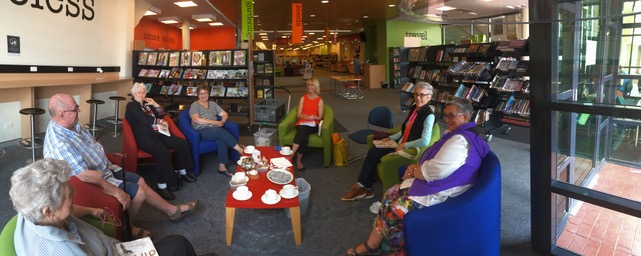At Tamworth City Library, Dianne Drew introduced me to Ita Hanssens at her local library. Ita in turn invited me to join the book club which was meeting in the sun pouring through a picture window onto the street.
 I was welcomed into the group with a cup of tea and a lamington. I confess the scene made me feel a bit jealous. It all looked so friendly. Like community. Like friendship. Like the sharing of ideas. I currently live in Geneva – a glamorous European life of tremendous isolation. While my set-up is perfect for writing, it’s foul for community. This is such a simple, generous way of bringing like-minded strangers together.
I was welcomed into the group with a cup of tea and a lamington. I confess the scene made me feel a bit jealous. It all looked so friendly. Like community. Like friendship. Like the sharing of ideas. I currently live in Geneva – a glamorous European life of tremendous isolation. While my set-up is perfect for writing, it’s foul for community. This is such a simple, generous way of bringing like-minded strangers together.
 Amanda Burke was the moderator. She presides over two book clubs – one which meets on Thursdays is comprised of 25-35 year olds (ironically called ‘Dusty Covers,’) and this one the pragmatically named ‘Third Monday Tamworth Book Club’.
Amanda Burke was the moderator. She presides over two book clubs – one which meets on Thursdays is comprised of 25-35 year olds (ironically called ‘Dusty Covers,’) and this one the pragmatically named ‘Third Monday Tamworth Book Club’.
Library Book Club Kits
The library keeps sets of ten copies of popular titles (classics and contemporary, with a wonderful mix of Australian authors.) The idea is that each kit has enough copies for a club to borrow all the necessary books at one time. This library services 30 local book clubs, with a 100 titles to choose from. That’s at least a thousand books.
Each year the library releases a list of available titles. Each member of each book club also needs to be a member of the library (some are run by the community, others by the library). They ask the groups to choose their books for the year in advance so they can manage the loans. Some libraries also supply suggested topics to discuss for the book, and will (as they were when I arrived) host the actual meeting in the library.
For November they’d read Robert Drew’s Whip Bird and were discussing it with mixed approval. Most complained that it took 200 pages before something happened. Although – came the counter argument – ‘the book was full of great characters.’ And ‘to be fair, someone got punched on page 97.’
It was my intension to be a fly on the wall, but ended up taking part in the discussion suggesting that the book sounded like it had the makings of a good TV sitcom – the central conceit of which is great characters stuck in a circular narrative. This opened the discussion for a while about film and television and which books they thought would make good adaptations. Finally they agreed Whip Bird would make good television.
Damn, now I’m going to have to read it.
I asked about which books they’ve liked so far. The only ones which were named with universal approval were both by Jane Harper’s The Dry and Force of Nature.
“Is that because of the rural themes?” I asked.
“No. I liked that,” said the only man in the group, “But it’s the gripping story. The characters are totally credible. It’s really well written.”
“And if you can guess who,” chimed in another reader, “you’ll never guess why.”
The group started throwing around the names of other books they’d enjoyed
* The Slap by Christos Tsiolkas resulted in the biggest discussion
* The Natural Way of Things by Charlotte Wood
* The House Within by Fiona Kidman
* All the Light We Cannot See by Anthony Doerr – “That was hard,” demured one of the women, “I didn’t finish it. Too slow for my likes.”
When Cutting for Stone by Abraham Verghese was mentioned an involuntary murmur went through the group. “Now that was hard.” And the conversation veered off into the books that had moved them, but that they hadn’t enjoyed.
* Unbroken by Laura Hillenbrand
* Journey to the Stone Country by Alex Miller
* Sarah’s Key by Tatiana de Rosnay
“I hated that book,” said the woman left of me, “But one of the things I love about book club is reading books I wouldn’t normally choose. I hated it, but I haven’t stopped thinking about it. Sometimes I’m glad I did it to the end.”


























